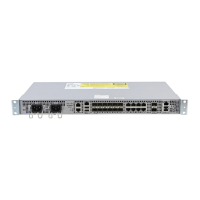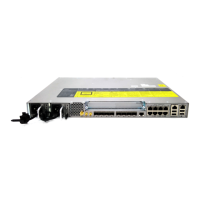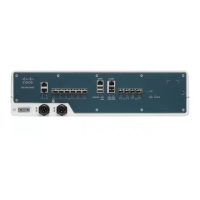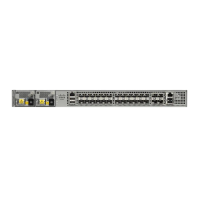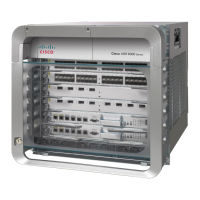Computing the IGP Path Using Dynamic Paths or Explicit Paths
You can either specify explicit paths or allow paths to be created dynamically. You can also specify bandwidth
parameters, which are flooded throughout the MPLS network through existing RSVP-TE extensions to Open
Shortest Path First (OSPF) and Integrated Intermediate System-to-Intermediate System (IS-IS).
The MPLS core network uses RSVP to enable end-to-end IP multicast connectivity. The tailend router and
the end point router use PIM to exchange multicast routing information with directly connected CE routers.
PIM is not configured in the MPLS core.
P2MP TE tunnels can co-exist with regular P2P TE tunnels. Existing path calculation and bandwidth preemption
rules apply in this case.
You create IGP paths by enabling dynamic path computation, configuring explicit paths through CLI commands,
or using both methods in your P2MP TE network.
•
Dynamic paths are created using Constrained Shortest Path First (CSPF) to determine the best path to
a destination. CSPF uses path constraints, such as bandwidth, affinities, priorities, and so on, as part of
the computation.
•
Explicit paths allows you to manually specify the path a sub-LSP uses from the headend router to the
tailend router. You configure static paths on the headend router.
Remerge Events
When explicit paths are configured with a limited number of equal cost links or paths, two sub-LSPs might
connect at a midpoint router through different ingress interfaces, but use the same egress interface. This is
called a remerge event, which can cause duplicate MPLS packets. If a router detects a remerge event, it sends
a PathErr Routing Problem: Remerge Detected message toward the headend router and the sub-LSPs are not
established. With dynamic paths, the router signals a path that avoids a remerge situation.
Crossover Events
With a P2MP tunnel, two sibling sub-LSPs (sub-LSPs that share the same link and label) are said to “cross
over” when they have different incoming interfaces and different outgoing interfaces on the same intersecting
node. The sibling sub-LSPs neither share input label nor output bandwidth. Avoid configuring crossover
LSPs, because they waste bandwidth. However, the duplication of sub-LSPs does not result in an error.
Benefits of MPLS Point-to-Multipoint Traffic Engineering
The P2MP TE feature provides the following benefits:
•
You can configure signaling attributes, such as affinities, administrative metrics, FRR protection, and
bandwidth constraints, when you set up P2MP TE sub-LSPs.
•
P2MP TE provides a single point of traffic control. You specify all the signaling and path parameters
at the headend router.
•
You can configure explicit paths to optimize traffic distribution.
•
Protocol Independent Multicast (PIM) is not needed in the MPLS core. Only the non-MPLS interfaces
on the tailend routers need to be configured with PIM.
MPLS Traffic Engineering Path Calculation and Setup Configuration Guide, Cisco IOS XE Release 3S (Cisco
ASR 920 Series)
16
MPLS Point-to-Multipoint Traffic Engineering
Computing the IGP Path Using Dynamic Paths or Explicit Paths

